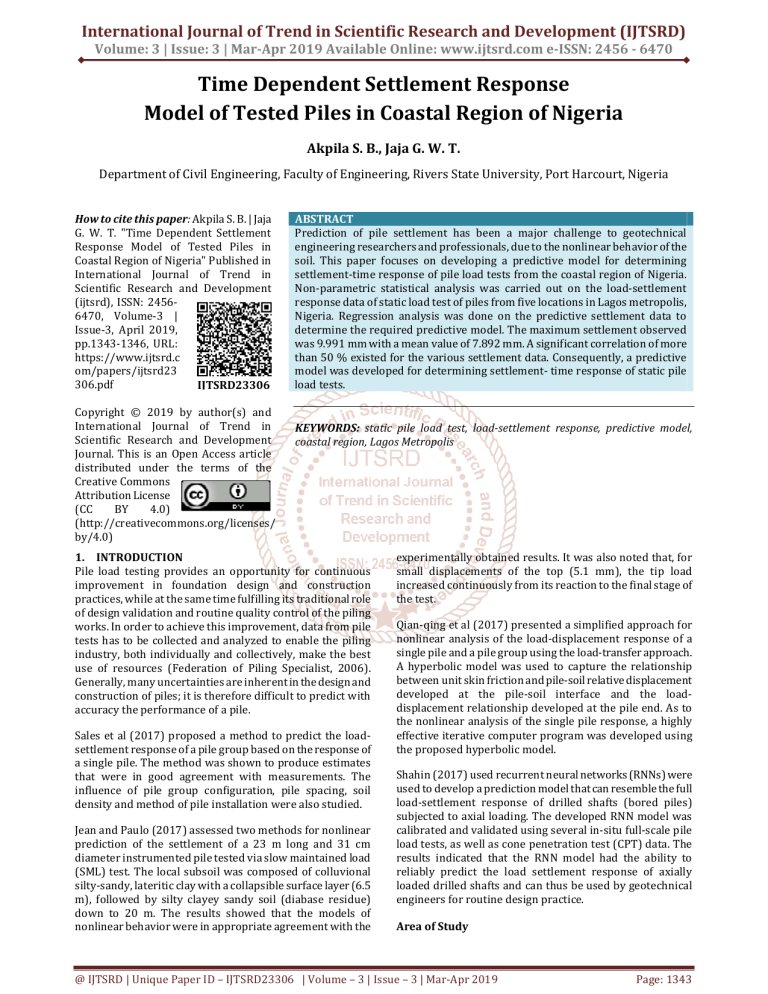
International Journal of Trend in Scientific Research and Development (IJTSRD)
Volume: 3 | Issue: 3 | Mar-Apr 2019 Available Online: www.ijtsrd.com e-ISSN: 2456 - 6470
Time Dependent Settlement Response
Model of Tested Piles in Coastal Region of Nigeria
Akpila S. B., Jaja G. W. T.
Department of Civil Engineering, Faculty of Engineering, Rivers State University, Port Harcourt, Nigeria
How to cite this paper: Akpila S. B. | Jaja
G. W. T. "Time Dependent Settlement
Response Model of Tested Piles in
Coastal Region of Nigeria" Published in
International Journal of Trend in
Scientific Research and Development
(ijtsrd), ISSN: 24566470, Volume-3 |
Issue-3, April 2019,
pp.1343-1346, URL:
https://www.ijtsrd.c
om/papers/ijtsrd23
306.pdf
IJTSRD23306
Copyright © 2019 by author(s) and
International Journal of Trend in
Scientific Research and Development
Journal. This is an Open Access article
distributed under the terms of the
Creative Commons
Attribution License
(CC
BY
4.0)
(http://creativecommons.org/licenses/
by/4.0)
ABSTRACT
Prediction of pile settlement has been a major challenge to geotechnical
engineering researchers and professionals, due to the nonlinear behavior of the
soil. This paper focuses on developing a predictive model for determining
settlement-time response of pile load tests from the coastal region of Nigeria.
Non-parametric statistical analysis was carried out on the load-settlement
response data of static load test of piles from five locations in Lagos metropolis,
Nigeria. Regression analysis was done on the predictive settlement data to
determine the required predictive model. The maximum settlement observed
was 9.991 mm with a mean value of 7.892 mm. A significant correlation of more
than 50 % existed for the various settlement data. Consequently, a predictive
model was developed for determining settlement- time response of static pile
load tests.
KEYWORDS: static pile load test, load-settlement response, predictive model,
coastal region, Lagos Metropolis
1. INTRODUCTION
Pile load testing provides an opportunity for continuous
improvement in foundation design and construction
practices, while at the same time fulfilling its traditional role
of design validation and routine quality control of the piling
works. In order to achieve this improvement, data from pile
tests has to be collected and analyzed to enable the piling
industry, both individually and collectively, make the best
use of resources (Federation of Piling Specialist, 2006).
Generally, many uncertainties are inherent in the design and
construction of piles; it is therefore difficult to predict with
accuracy the performance of a pile.
Sales et al (2017) proposed a method to predict the loadsettlement response of a pile group based on the response of
a single pile. The method was shown to produce estimates
that were in good agreement with measurements. The
influence of pile group configuration, pile spacing, soil
density and method of pile installation were also studied.
Jean and Paulo (2017) assessed two methods for nonlinear
prediction of the settlement of a 23 m long and 31 cm
diameter instrumented pile tested via slow maintained load
(SML) test. The local subsoil was composed of colluvional
silty-sandy, lateritic clay with a collapsible surface layer (6.5
m), followed by silty clayey sandy soil (diabase residue)
down to 20 m. The results showed that the models of
nonlinear behavior were in appropriate agreement with the
experimentally obtained results. It was also noted that, for
small displacements of the top (5.1 mm), the tip load
increased continuously from its reaction to the final stage of
the test.
Qian-qing et al (2017) presented a simplified approach for
nonlinear analysis of the load-displacement response of a
single pile and a pile group using the load-transfer approach.
A hyperbolic model was used to capture the relationship
between unit skin friction and pile-soil relative displacement
developed at the pile-soil interface and the loaddisplacement relationship developed at the pile end. As to
the nonlinear analysis of the single pile response, a highly
effective iterative computer program was developed using
the proposed hyperbolic model.
Shahin (2017) used recurrent neural networks (RNNs) were
used to develop a prediction model that can resemble the full
load-settlement response of drilled shafts (bored piles)
subjected to axial loading. The developed RNN model was
calibrated and validated using several in-situ full-scale pile
load tests, as well as cone penetration test (CPT) data. The
results indicated that the RNN model had the ability to
reliably predict the load settlement response of axially
loaded drilled shafts and can thus be used by geotechnical
engineers for routine design practice.
Area of Study
@ IJTSRD | Unique Paper ID – IJTSRD23306 | Volume – 3 | Issue – 3 | Mar-Apr 2019
Page: 1343
International Journal of Trend in Scientific Research and Development (IJTSRD) @ www.ijtsrd.com eISSN: 2456-6470
The study area is situated in Lagos, Nigeria with latitude
6.465422°N and longitude 3.406448°E with the gps
coordinates of 6° 27' 55.5192'' N and 3° 24'23.2128'' E
shown in Figure 1. Static Pile load tests were carried out on
five locations within the study area. The locations include
Lekki Phase 1, Ikorodu, Lekki, Aja and Onikan as shown in
Figure 2.
3.
4.
5.
6.
7.
Hydraulic jack of appropriate capacity (800tons);
connected to hydraulic pump
Oil manometer of suitable capacity
Kentledge or Dead weights (normally in form of
concrete cubes of 1m3 and 24 kN or 2.4 tons), etc.
nos. steel reference beams
Nos. dial gauges, capable of measuring movements
within an accuracy of 0.01mm.
Arrangement of Load Test Platform
The arrangement for an axial compression test is generally
done using either;
(a) By means of a jack which obtains its reaction from
kentledge heavier than the required test load
(b) By means of jack which obtains its reaction from tension
piles or other suitable anchors (section 7.5.5.2 of BS
8004; 1986).
Figure1. Map showing the study area.
(Source: Google Maps, 2019)
Pile Load Test Procedure
The pile load test involves the application of the load in
stages, with the load at each stage being maintained constant
until the resulting settlement of the pile virtually ceases
before the application of the next load increment.
Maximum load to be applied on a single pile for this method
will not exceed 2.0 x safe working load. The load is applied in
increments of 25 % of the design load. Each load increment
is maintained until the rate of settlement is not greater than
0.05 mm /30 minutes or until a maximum of about 2 hours
have elapsed, whichever occurs first.
The maximum load is maintained on the pile for 6 hours,
except in the event that the average rate of settlement is not
greater than 0.05 mm /30 minutes. Unloading of pile is done
in decrements of 25 % of the maximum load or as specified
by the client.
Figure 2: Map showing the locations of the static pile load
test within the study area. (Source: Google Maps, 2019)
2. Materials and Methods
Static Load Test
Static load test of a pile or group of piles is used to establish
an allowable load. Static load test were carried out on piles
located in include Lekki Phase 1, Ikorodu, Lekki, Aja and
Onikan. The applied load is usually maximum of 150 % to
200 % of the design safe working load. The Primary
objectives of Static load test are;
To establish load-deflection relationships in the pile-soil
system,
To determine capacity of the pile-soil system, and
To determine load distribution in the pile-soil system.
3. Results and Discussion
Figure 3 shows the settlement measured from the static pile
load tests at Lekki Phase 1, Ikorodu, Lekki , Aja and Onikan.
It can be observed from Figure 3 that Aja has the least
settlement values whereas the highest settlement values
where observed in Ikorodu. Table 1 shows that the
maximum settlement observed from the various settlement
was 9.991 mm with a mean value of 7.892 mm.
These tests will confirm design assumptions or provide
information to allow those assumptions and the pile design
to be modified (Geotechnical Engineering Bureau, 2007).
Equipment and Instrumentation for Static Load Test
Major equipment required for applying compressive load on
a test pile generally include, but are not limited to the
following:
1. test beams - primary and secondary
2. bearing plates
Figure 3: Settlement measured from static pile load tests
from the various locations.
@ IJTSRD | Unique Paper ID – IJTSRD23306 | Volume – 3 | Issue – 3 | Mar-Apr 2019
Page: 1344
International Journal of Trend in Scientific Research and Development (IJTSRD) @ www.ijtsrd.com eISSN: 2456-6470
Table 1: Descriptive statistics of settlement measured from static pile load test
Test Type
LEKKI IKORODU LEKKI PHASE 1
AJA
ONIKAN
Mean
2.94132
7.89220
5.468
2.92067 5.4934
Standard Error
0.46096
0.34550
0.18162 0.3453
Median
3.097
8.876
5.0725
2.463
5.073
Mode
2.4625
8.775
5.0725
2.463
5.073
Standard Deviation
1.13692
2.87868
2.15766
1.1342
2.1564
Sample Variance
1.29258
8.28679
4.65548
1.2865
4.6499
Kurtosis
-0.3194
2.22868
-0.1844
-0.3184
-0.151
Skewness
-0.4493
-1.9201
-0.4734
-0.3887
-0.511
Range
4.43
9.991
8.23
4.47
8.23
Minimum
0
0
0
0
0
Maximum
4.43
9.991
8.23
4.47
8.23
Sum
114.716
307.8
213.252
113.91
214.24
Count
39
39
39
39
39
Confidence Level (95.0%) 0.3686
0.9332
0.6994
0.36767 0.69901
In order to develop a model to predict the settlement from static pile load test in the coastal region of Nigeria, a predicted
settlement which is the mean settlement observed from the static pile load tests at Lekki Phase 1, Ikorodu, Lekki, Aja and
Onikan at the same time interval is assumed. Kendall’s tau_b test which is a non-parametric test is used to check for significant
correlations between the settlement measured from static pile load tests from the various locations and the predicted
settlement. Table 2 shows the result of the Kendall’s tau_b test on the settlement data and a significant correlation of more
than 50 % existed for the various settlement data.
Based on the significant correlation of the settlement data from the Kendall’s tau_b the values from the calculated predicted
settlement will be used for modelling the relationship between the settlement and time for soils from the coastal region of
Nigeria. Figure 4 shows the relationship between the settlement and time for predicted settlement of soils from the coastal
region of Nigeria.
.
Table 2: Kendall’s tau b correlation of settlement measured from static pile load tests
Predicted
Time
Lekki
Test
Lekki Ikorodu
Aja
Onikan
Settlement
(Hrs)
Phase 1
(Mm)
Correlation
1.000 .534**
.514**
.738**
.534**
.774**
.657**
Coefficient
TIME (hrs)
Sig. (2-tailed)
.000
.000
.000
.000
.000
.000
LEKKI
IKORODU
Kendall's
tau_b
LEKKI PHASE 1
AJA
ONIKAN
PREDICTED
SETTLEMENT
(mm)
N
Correlation
Coefficient
Sig. (2-tailed)
N
Correlation
Coefficient
Sig. (2-tailed)
N
Correlation
Coefficient
Sig. (2-tailed)
N
Correlation
Coefficient
Sig. (2-tailed)
N
Correlation
Coefficient
Sig. (2-tailed)
N
Correlation
Coefficient
Sig. (2-tailed)
N
39
39
39
39
39
39
39
.534**
1.000
.595**
.536**
.932**
.562**
.796**
.000
39
39
.000
39
.000
39
.000
39
.000
39
.000
39
.514**
.595**
1.000
.552**
.570**
.512**
.594**
.000
39
.000
39
39
.000
39
.000
39
.000
39
.000
39
.738**
.536**
.552**
1.000
.577**
.962**
.742**
.000
39
.000
39
.000
39
39
.000
39
.000
39
.000
39
.534**
.932**
.570**
.577**
1.000
.603**
.783**
.000
39
.000
39
.000
39
.000
39
39
.000
39
.000
39
.774**
.562**
.512**
.962**
.603**
1.000
.767**
.000
39
.000
39
.000
39
.000
39
.000
39
39
.000
39
.657**
.796**
.594**
.742**
.783**
.767**
1.000
.000
39
.000
39
.000
39
.000
39
.000
39
.000
39
39
@ IJTSRD | Unique Paper ID – IJTSRD23306 | Volume – 3 | Issue – 3 | Mar-Apr 2019
Page: 1345
International Journal of Trend in Scientific Research and Development (IJTSRD) @ www.ijtsrd.com eISSN: 2456-6470
4.1 Recommendations
Based on the results of this study, it is recommended that the
predictive model developed in this study should be used in
predicting settlement- time response of static pile load tests.
5. References
[1] British Standard Code of Practice for Foundations BS
8004: (1996).
[2] Geotechnical Engineering Bureau. (2007). Geotechnical
Control Procedure. New York State Department of
Transportation.
[3] Federation of Piling Specialists (2006). Handbook on
pile load testing. Forum Court, Bromley, UK.
Figure 4: Relationship between the settlement and time
for predicted settlement
In Figure 3, there is a positive relation between the
settlement and time with an R2 correlation coefficient of
0.8567. The predictive model is given in Equation 1 as
follows;
(R2 = 0.8567) (1)
4. Conclusion
Based on the results of this study, the following conclusions
are drawn:
1. The maximum settlement observed from the various
settlement from the coastal region of Nigeria was 9.991
mm with a mean value of 7.892 mm.
2. A significant correlation of more than 50 % existed for
the various settlement data from various locations in the
coastal region of Nigeria.
3. A positive correlation exists between settlement and
time with an R2 correlation coefficient of 0.8567. The
predictive model of Equation 1 may be used to evaluate
pile settlement.
[4] Garcia, J. R. & Rocha-de Albuquerque P.J. (2018). Model
of nonlinear behavior applied to prediction of
settlement in deep foundations. DYNA, 85(205), pp.
171-178, June, 2018.
[5] Google
(2019).
Retrieved
from
https://espace.curtin.edu.au, 14th February, 2019.
[6] Qian-qing, Z., Shu-cai, L., Fa-yun, L., Min, Y., & Qian, Z.
(2014). Simplified method for settlement prediction of
single pile and pile group using a hyperbolic model.
International Journal of Civil Engineering Transaction B:
Geotechnical Engineering, Vol. 12, No. 2, 146-159
[7] Sales, M.M., Prezzi, M., Salgado, R., Choi, Y. S., & Lee, J.
(2017). Load-Settlement Behaviour of Model Pile
Groups in Sand under Vertical Load. Journal of Civil
Engineering and Management, 23(8), 1148–1163.
https://doi.org/10.3846/13923730.2017.1396559.
[8] Shahin, M. A. (2017). Load-Settlement Modeling of
Axially Loaded Drilled Shafts 26 using CPT-Based
Recurrent Neural Networks. Technical Note.
Department of Civil Engineering, Curtin University,
Australia.
@ IJTSRD | Unique Paper ID – IJTSRD23306 | Volume – 3 | Issue – 3 | Mar-Apr 2019
Page: 1346





